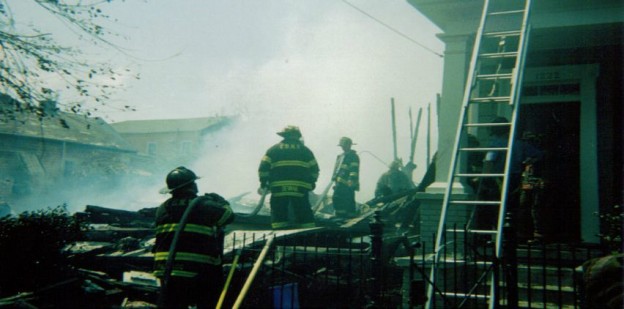

August 28, 2017 | Categories: B2B, Profiles
(Excerpted from a chapter in the book I co-authored, FDNY 150: Celebrating the Past, Present and Future.)
“When the FDNY arrived in New Orleans a few days after Katrina, we saw their equipment was very damaged, their fire stations were wiped out, and the fire department was temporarily stationed at nearby Our Lady of Holy Cross college campus because it was above water and had only a little bit of electricity and running water,” said retired FDNY Chief of Department, Edward Kilduff, who was a Deputy Incident Commander for the FDNY Incident Management Team. The FDNY responded to New Orleans’ call for help, sending 360 handpicked Firefighters and support vehicles driven down with as many resources as possible. “We picked senior firefighters because they knew how involved the New Orleans firefighters were post-World Trade Center and we wanted to give them the opportunity to say thank you.” Dozens of New Orleans Firefighters came to New York after the Trade Center in 2001 and spent weeks and weeks up here helping the FDNY out, helping at Ground Zero, and having a presence at our funerals.
“When we landed in New Orleans, we grabbed a couple of trucks and about a day’s worth of water and food supplies from the airport, then traveled out to this college where we found the entire New Orleans Fire Department (NOFD),” said Chief Kilduff.
The IMT was there to support and supplement the New Orleans fire department from the logistics and planning perspective, but also to help set up a camp so the NOFD could function. “I’m proud of our IMT and task force of Firefighters for being able to set up a camp in a week’s time facilitated feeding 1,500 people,” said Chief Kilduff. “It really was a remarkable feat considering where we started with the infrastructure.”
FDNY Firefighters worked 18-hour days for two weeks, fighting fires, building the camp, or helping rebuild the houses of the New Orleans Firefighters. Just about everyone was evacuated by the time the FDNY showed up. All of the firefighters demonstrated extraordinary resourcefulness, work ethic, and commitment, said Chief Kilduff.
The devastation of the New Orleans fire department really hit home with Chief Kilduff. About 90 percent of NOFD lived in New Orleans, and almost all of them had severe damage to their houses. “It was inspiring to see the New Orleans Firefighters go to work every day, even though their families were displaced to other states and their homes unlivable,” said Chief Kilduff. “The fact that they were able to hang in there as long as they did was pretty inspirational,” remembered Chief Kilduff.
FDNY Chief of EMS James Booth was the sole paramedic from FDNY to assist the New Orleans EMS. “We tried to find ways to alleviate the stress of work, to give the New Orleans paramedics time to help take care of their families and homes, and help their department function,” said Chief Booth. “My responsibility was to look after the New York Firefighters down there, to make sure they were getting the care they needed and resting up when they needed to.” Chief Booth says he was impressed by the friendships that developed just working with the New Orleans Firefighters and Paramedics under the conditions they faced. “You develop these lasting bonds. They could be from New Orleans and we would be from New York both have the same desires and blood running through us as far as protecting the community,” said Chief Booth.
In addition to the efforts in New Orleans, the FDNY also sent a Special Operations Command team to Biloxi, Miss., to assist. Battalion Chief Joseph Downey was part of that team and said they conducted “boots on the ground” efforts, including searches of collapsed structures and humanitarian work.
“To this day, I still have FDNY Firefighters come up to me and say, ‘Chief, I was with you in New Orleans, ‘or ‘Chief, I went down to Katrina with you.’ And, really, for every Firefighter who went down there, it was an extraordinary time in their career and they demonstrated remarkable work ethic and the commitment for two weeks straight,” he said.
The NOFD had excellent leadership down there so we had confidence they would be up and running as soon as possible, said Chief Kilduff. “They were an accomplished group, they just needed the ability to get on their feet, but once they did, they were fine,” said Chief Kilduff.
(Excerpted from the chapter on “Beyond City Limits” about the times the FDNY left NYC’s borders to help other cities and countries. All proceeds from the FDNY 150 book benefit the Foundation of the Fire Department of New York.)
Leave a Reply